Bright and early the next morning, we were downstairs and waiting in the brilliant sunshine for our historical tour of the other two key Spanish centres of trade - San Lorenzo & Portobello, which together are a UNESCO World Heritage Site*. This time it was Jeff (also from Barefoot Panama) who fetched us and much to our (pleasant) surprise we were joined by Maria from Seattle who had arrived into Panama the previous day.
Heading out of town, we first needed to cross the canal to get to Fort San Lorenzo, our first stop of the morning. We had been warned the day before by Kevin that crossing the canal can be pretty hit and miss and can involve long waits depending on what was happening shipping wise. I should have figured out from this description that we would be getting a quite close preview of the canal. What I wasn't expecting was to be on a rather rickety retractable "bridge" a mere handful of meters above the low water point of the first set of the Gatun Locks. Talk about amazing! And even better we got there right in the nick of time and drove straight through. . .with our mouths wide open.
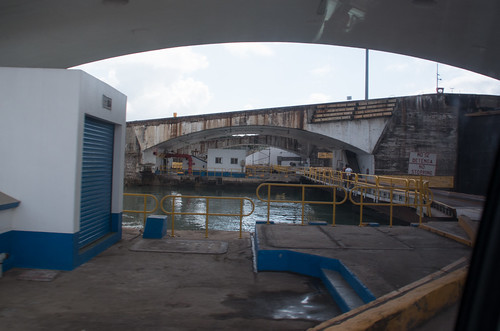
Approaching the locks.
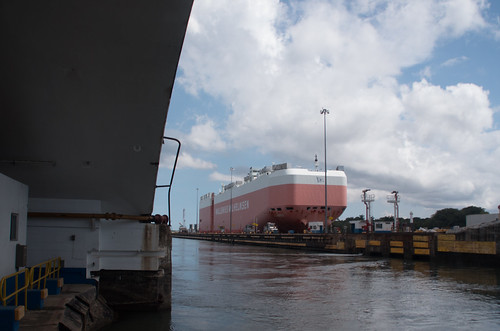
Coming out from under the arch, and there is a ship getting ready to transit through.
After a beautiful drive through Chagres National Park (which protects one of the important watersheds for the canal) and spotting quite a few interesting birds including a yellow headed caracara carrying off a rather large frog, we came to an unexpected (for us, Jeff clearly knew what was going on) military checkpoint that was the former entrance to the ex US base of Fort Sherman. The Panamanian military obviously still uses it as a training ground (they were doing some sort of amphibious manoeuvres while we passed through), but most of the buildings have been completely left to rot.
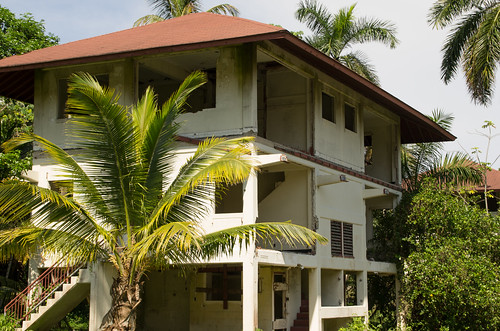
One of the old apartments for servicemen and their families.

It was a really striking contrast, but you could see the strategic importance with the shipping of the canal clearly visible in the background (see above).
A short drive through later, we arrived at Fort San Lorenzo. . .completely alone. It was quite surreal having the whole area to ourselves, but also a wonderful luxury and allowed us to explore almost completely unencumbered.
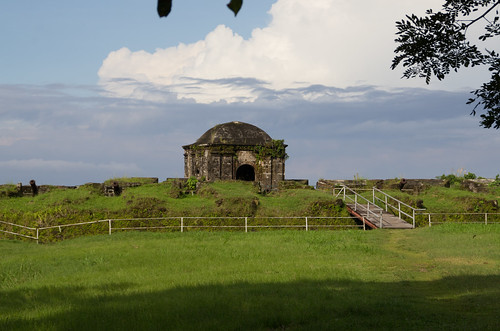
The entrance to the old fort
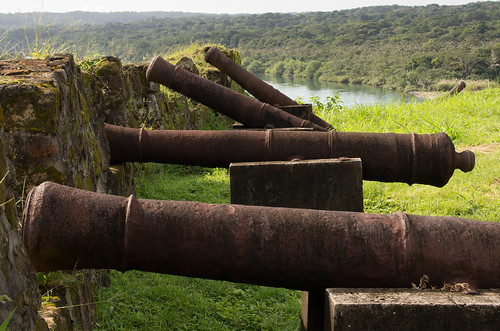
All the old canons, lined up. Unclear if these are originals for this location or if they were brought in from somewhere else.

Looking over at the area just beyond the canons, you can see the mouth of the Chagres River as it empties into the Caribbean Sea. In the glory days of the Spanish empire, this was one of the primary routes for bringing gold and silver from the Pacific to the Atlantic and so onward to Spain.

Looking back at the ruins from the Caribbean side.

Part of the pseudo still free standing guard rooms.

Another view from on top of the eastern fortification wall.

evidence we were, in fact, there, plus a peek at my new haircut for those of you who haven't seen it yet.
It was eerily beautiful and in the bright morning sun hard to imagine why more people didn't make the trip, but then again, I'm not sure how many visitors it could handle without additional damage being done. As you can see, there were virtually no restrictions to our access and no evidence of any sort of preservation activity. It's rather obvious why they've been designated as being "in danger".
After basking in the beauty and poking around to our hearts' content, it was back in the van and retracing our steps, back through Fort Sherman (where we got to chase after a military vehicle that didn't listen to their compatriots at the check point - kind of awesome), across the locks and over to the other side of Colon for yet another picturesque drive towards Portobello along the coast.
Arriving in Portobello we parked just outside the main square, and Jeff remarked how much more active the town was. Apparently it was a few days before one of the major local festivals - the pilgrimage and festival of the Christo Negro or Black Christ, so named for a very emotive statue of Christ carved from dark wood that resides in the local church. And indeed all through town the market stalls were beginning to set up and music was played from various corners.

the "unusually busy" town square

And turning around behind me, the old customs house where the gold and silver would be stored before being shipped to Spain once a year.
We walked through the big arches to the other side where we would also enter the main fortifications of the town, but first, we had to stop for a refreshment - a lady was serving fresh, green coconuts to all comers. I hadn't had coconuts like this since our trip to Singapore all those years ago.

hack off the top

add a straw - yum!
Suitably refreshed, it was time to explore the ruins of the old fort.
 The lintel showing the date the town was founded - 1758
The lintel showing the date the town was founded - 1758
Shortly after passing through the main "gate", Jeff pulled us aside to show us the construction of the walls itself. Not only was it made of the usual brick and stone, but they had also included bits of coral. Talk about using whatever had come to hand! Below is one example, but we spotted others as we looked around.


Nothing more threatening these days than fishing boats.

What they think may have been the old powder store. Now more or less underwater.

Adventurer extraordinaire (also you can see other examples of the different kinds of coral used for building the walls)

Standing on the far side, looking back towards the customs house.
After poking about the ruined fort for a bit, we walked through the increasingly busy town to have a look at what remains of the old town.

The previous incarnation of the cathedral and hospital. Now it serves as a museum, which was closed the day we were there.
Then crossing over to visit the church that currently houses El Christo Negro, Iglesia de San Felipe.
It is quite a plain little church, but quite airy and with plenty of room
And the queues were already forming, even though it was still 3 days to the festival.

On the other side of the altar is a statue to our lady of mercy. You can just see that on the rosary between her hands are a pair of handcuffs. She's considered to particularly be concerned for convicts. While not paraded like the Black Christ, apparently families of those in jail or prison will come for miles to pray for their loved ones rehabilitation and safety.
We didn't stay long, while most people were praying, others were busy about the church getting it ready for the up coming festivities.
From there we walked through the rapidly expanding market back towards the customs house where we would go through the little museum and have a look at the gift shop which was also the old reception room and the only room refurbished to look as it would have in the 18th century.

Voila - that's Jeff off to the right. Realised later that I never g to a proper picture of him! Shame. Anyway, the part that was fenced off in the middle (and which I couldn't get a decent picture of due to the funky lighting) was a portion of the original floor under plexiglass.
After poking about it was time for lunch. Jeff took us down the road to a little placed called "Los Canones" just on the water's edge. A stunning setting for some really fantastic seafood. I had a selection of ceviches (sea bass & octopus) and a starter portion of their queen clam in cocunt sauce. S had some of their grilled sea bass on a bed of rice with fried plantains (patacones). Everything was cooked perfectly and very flavourful. Combined with a glass of the local beer it was pure bliss.
After lunch it was just back to Colon, more specifically to the port, for us to pick up our ship. Let's just say that the drive through town thoroughly convinced us that all the advice we'd read about Colon was absolutely true. A rougher more shabby looking town I'm not sure I had ever seen. Kind of a shame as there were quite a few buildings that despite their advanced stage of dilapidation had some lovely details.
We said good-bye to Jeff and Maria and headed off through what looked more like a shopping mall than a cruise port to find our ship. Unusually, there wasn't anyone to check our tickets or any other documentation and we weren't stopped until about 100 meters from the ship by a guy who spoke no English and who then reverted to gestures, ignoring our attempts at getting an explanation in Spanish. This is what is colloquially referred to as Not. Good.
He gestured for us to go off to the side and (through more gestures) we understood he wanted to take our luggage. This we patently refused. Cue a very frustrating exchange for some minutes including calling over one of his friends. I could see the ship from the area where we were and so figured if things got difficult (they almost did when he tried to take my handbag off my shoulder) we could make a dash for it or at least a lot of noise and surely one of the staff members would come over to help (I hoped). Right as things were getting quite heated (us not understanding what they wanted, them not explaining anything), another guy came out with what was obviously a drug dog. At that stage we finally understood what was going on and set the bags aside for a thorough sniffing. Disaster averted. On the way over the last hundred meters, Stephen finally got one of the guys to actually talk to us and he tried to say that it we would have complied right away had we known that all they wanted was to have the dog look at our bags. Instead of courtesy back instead we got chastised (in Spanish) for not telling them sooner we spoke Spanish!
From there it was a snip to check in (it seemed that we were the absolute last guests on board, even with two and a half hours still to go), and off to our suite to get cleaned up and unpacked before the muster drill and introductory talks. It was at this moment that Stephen and I started to think that perhaps our definition of "adventure travel" might be somewhat different than Silversea's. But, the suite was beautiful (with a very spacious verandah that would come in very handy indeed), the staff very kind, some of the other guests pretty interesting, and we were committed to having fun regardless.
(as always, these are only a selection of the pictures I took on the day. For the rest of the set, head over to my flickr page. You can also see Stephen's pictures too here.)
















 The lintel showing the date the town was founded - 1758
The lintel showing the date the town was founded - 1758






































